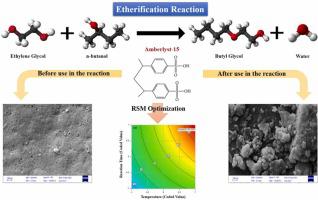Process Safety and Environmental Protection ( IF 6.9 ) Pub Date : 2022-07-30 , DOI: 10.1016/j.psep.2022.07.059 Borna Bayat , Kambiz Tahvildari , Alireza Hemmati , Amin Bazyari , Ahad Ghaemi

|
This work aims to produce butyl glycol from the etherification of ethylene glycol (EG) and n-butanol (NB) using different heterogenous Amyberlyst-15 catalysts in a pressurized reactor tank. Experiments were designed by response surface methodology according to the central composite design (RSM-CCD). Three operating conditions of temperature (140–200 °C), reaction time (2–22 h), and EG: NB molar ratio (1:1–1:9) were considered to model and optimize the EG conversion under fixed pressure and catalyst weight. A quadratic conversion model was proposed as a function of independent and combined studied parameters, predicting the experimental data with high accuracy (R2 > 0.98). According to the response surface results, all variables positively affected the response. The optimal reaction condition for maximizing conversion was at 1:8.2, 4.1 h, and 200 °C, achieving the EG conversion of 86.12 %. Furthermore, the catalyst reusability was checked after four cycles, indicating a reduction of about 15 % in conversion after each cycle. The FESEM, FTIR, XRD, BET, and TGA analyses characterized the fresh catalyst and used catalyst after the fourth cycle. Both samples had a spherical morphology, and the used catalyst contained carbon-based sediments, intensifying the stretching vibration of C-O bond peaks. The pore diameter and volume of the fresh catalyst were 18.93 nm and 2.38 cm3/g, respectively, while these values were 22.07 nm and 0.36 cm3/g for the used catalysts after the fourth cycle. The reduction in the catalytic activity of the used sample can be because of the pore deformation.
中文翻译:

使用amyberlyst-15纳米结构多相催化剂醚化乙二醇制备乙二醇单丁醚
这项工作旨在通过在加压反应罐中使用不同的异相 Amyberlyst-15 催化剂对乙二醇(EG) 和正丁醇 (NB) 进行醚化来生产丁二醇。根据中心复合设计(RSM-CCD)通过响应面方法设计实验。考虑温度(140–200 °C)、反应时间(2–22 h)和 EG:NB 摩尔比(1:1–1:9)三种操作条件来模拟和优化固定压力下的 EG 转化率和催化剂重量。提出了一个二次转换模型作为独立和组合研究参数的函数,以高精度预测实验数据( R 2> 0.98)。根据响应面结果,所有变量都对响应产生积极影响。转化率最大化的最佳反应条件为 1:8.2、4.1 h 和 200 °C,EG 转化率达到 86.12%。此外,在四个循环后检查催化剂的可重复使用性,表明每个循环后转化率降低了约 15%。FESEM、FTIR、XRD、BET 和TGA分析表征了第四个循环后的新鲜催化剂和使用过的催化剂。两种样品都具有球形形态,使用的催化剂含有碳基沉积物,增强了 CO 键峰的伸缩振动。新鲜催化剂的孔径和体积分别为 18.93 nm 和 2.38 cm 3 /g,而这些值分别为 22.07 nm 和 0.36 cm 3/g 表示第四次循环后使用的催化剂。所用样品的催化活性降低可能是由于孔变形。











































 京公网安备 11010802027423号
京公网安备 11010802027423号